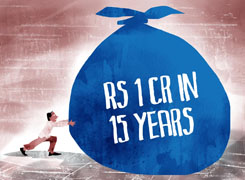Ramalingam Kalirajan |10874 Answers |Ask -Follow
Mutual Funds, Financial Planning Expert - Answered on Jun 24, 2025
He has an MBA in finance from the University of Madras and is a certified financial planner.
He is the director and chief financial planner at Holistic Investment, a Chennai-based firm that offers financial planning and wealth management advice.... more

Hi, Need your help to review my SIP allocation: Im 36 y/o with take home post tax 2.8L per monthly. My SIP portfolio looks like this(monthly) Digital gold investment : 35k SBI contra fund growth - 10k HDFC flexi cap fund - 10k HDFC gold ETF -10k SBI bluechip direct plan - 10k Aditya Birla sunlife direct fund -10k Bandhana small cap - 10k Plus I have invested in shares and also have few office RSUs. My immediate plan is to go for home in next 2-3 years and post that save for kids education plus retirement.Please review and suggest few more investment plans. Thanks S
Monthly Income and Savings Capacity
Take-home income is Rs. 2.8 lakhs per month.
Your current monthly SIP is Rs. 85,000.
This is nearly 30% of your income, which is excellent.
You also hold RSUs and direct shares, which adds further value.
You are thinking long term – home, child’s education, and retirement. That’s very good.
Let’s evaluate each investment one by one now.
Digital Gold – Rs. 35,000/month
This is a high monthly investment in digital gold.
Gold should not exceed 10-15% of total long-term portfolio.
Digital gold doesn’t give regular income or compounding benefits.
It has storage safety, but no taxation benefit.
You are also investing in gold ETF. That doubles exposure.
Better to reduce digital gold to Rs. 5,000–7,000 per month.
Shift balance to diversified mutual funds with long-term potential.
HDFC Gold ETF – Rs. 10,000/month
Another gold-based investment. This overlaps with digital gold.
You are over-allocated to gold. This limits long-term growth.
Gold should be a hedge, not a primary asset.
Please stop this SIP.
Redirect this Rs. 10,000 into equity mutual funds.
SBI Contra Fund – Rs. 10,000/month
Contra funds follow contrarian investing style.
They take risky sectoral bets.
They are not suitable for core portfolio.
Volatility can be very high in short and medium term.
You can consider reducing this to Rs. 5,000.
Redirect balance to more stable fund types.
HDFC Flexi Cap Fund – Rs. 10,000/month
Flexi-cap category offers diversification across market caps.
They allow fund manager flexibility.
This is a good choice for core allocation.
You can continue this SIP.
Increase gradually if gold allocation is reduced.
SBI Bluechip Direct Plan – Rs. 10,000/month
Important Concern:
You have invested in direct plan of this fund.
Direct plans offer lower expense ratio.
But they offer no service, review, or guidance.
There is no certified financial planner in between.
You are missing goal-based planning and rebalancing.
This can hurt your portfolio in long run.
Why Regular Plan via MFD with CFP is better:
Regular plan connects you to a CFP-certified MFD.
They help design goal-specific investment strategy.
They assist in tax planning and review periodically.
You will also get behavioural coaching during market falls.
With a direct plan, these services are absent.
Action Point:
Switch to regular plan of the same scheme via a certified MFD.
They will support with planning, not just execution.
Aditya Birla Sun Life Direct Fund – Rs. 10,000/month
Concern again:
Another direct plan investment.
Disadvantages are same as mentioned above.
No access to guided review, advisory, and rebalancing.
Regular plans are more useful when backed by a CFP-certified MFD.
Suggestion:
Stop SIP in direct plan.
Restart in regular plan through a qualified MFD.
You will benefit more in long-term wealth creation.
Bandhan Small Cap Fund – Rs. 10,000/month
Small cap funds can be volatile in short term.
But they deliver well in long term.
However, allocation should be limited to 10–15%.
Maintain current SIP amount.
Don’t increase beyond this unless risk tolerance is high.
Investment in Shares and RSUs
Individual stocks are risky if not actively monitored.
RSUs are good, but depend on employer performance.
Diversification becomes weak if you rely too much on company shares.
Regular profit booking and shifting to mutual funds is wiser.
Goals: House in 2–3 Years
This is a short-term goal.
Equity mutual funds are not suitable for this time frame.
Avoid investing further for this goal in equity or gold.
Start a separate SIP in ultra-short duration debt fund or RD.
Keep your down payment in 100% safe, low-volatility product.
Goals: Children’s Education
This is a long-term goal, assuming child is under 10.
Best suited for diversified equity mutual funds.
You can also consider child-specific mutual fund plans.
Avoid ULIP or insurance-linked products.
SIP through a CFP-guided MFD is most suitable.
Retirement Planning
At 36, you have 20–25 years to build retirement corpus.
Retirement corpus needs growth, safety, and inflation beating returns.
Equity mutual funds through regular SIPs are ideal.
Consider flexi-cap, large & mid-cap, and balanced advantage funds.
NPS can also be added for extra tax-saving and retirement focus.
Don't rely on employer RSUs alone for retirement.
Problems with Index Funds
You haven’t mentioned index funds. But if you ever consider them:
Index funds have no active management.
They can’t protect during market crashes.
They invest in poor-quality stocks just because they are in the index.
They cannot exit risky sectors in a falling market.
You get average returns, not outperformance.
Active Funds are Better Because:
They are managed by experienced fund managers.
They adapt to changing economic and market conditions.
They avoid poor-performing stocks.
They give opportunity to beat index returns.
A certified financial planner will always use active funds for long-term wealth.
Summary of Actions to Take
Reduce digital gold SIP from Rs. 35,000 to Rs. 5,000–7,000.
Stop gold ETF SIP of Rs. 10,000 fully.
Cut contra fund SIP to Rs. 5,000.
Exit direct plans and move to regular plans with help of a certified MFD.
Allocate more to flexi-cap, large & mid-cap, and hybrid equity funds.
Keep short-term goals like house purchase in debt instruments.
Track stock exposure and reduce reliance on RSUs.
Continue small cap SIP but don’t over-allocate.
Create separate SIPs for child’s education and retirement.
Final Insights
Your income level gives you strong investment potential.
You are already saving a good percentage monthly. Very good discipline.
But allocation needs reshaping to remove concentration in gold.
Direct plans offer no advisory help. That creates blind spots.
Actively managed mutual funds via certified MFDs give goal-based structure.
For short-term needs like a home, equity is not suitable.
For long-term goals like retirement and education, equity mutual funds are best.
A certified financial planner can create personalised roadmaps for each goal.
This kind of structured, reviewed investment can ensure you reach your goals without stress.
Best Regards,
K. Ramalingam, MBA, CFP,
Chief Financial Planner,
www.holisticinvestment.in
https://www.youtube.com/@HolisticInvestment
You may like to see similar questions and answers below
Ramalingam Kalirajan |10874 Answers |Ask -Follow
Mutual Funds, Financial Planning Expert - Answered on Apr 05, 2024
Ramalingam Kalirajan |10874 Answers |Ask -Follow
Mutual Funds, Financial Planning Expert - Answered on Apr 02, 2024
Ramalingam Kalirajan |10874 Answers |Ask -Follow
Mutual Funds, Financial Planning Expert - Answered on May 14, 2024
Ramalingam Kalirajan |10874 Answers |Ask -Follow
Mutual Funds, Financial Planning Expert - Answered on May 25, 2024
Ramalingam Kalirajan |10874 Answers |Ask -Follow
Mutual Funds, Financial Planning Expert - Answered on Jun 13, 2025
Mayank Chandel |2569 Answers |Ask -Follow
IIT-JEE, NEET-UG, SAT, CLAT, CA, CS Exam Expert - Answered on Dec 08, 2025
Mayank Chandel |2569 Answers |Ask -Follow
IIT-JEE, NEET-UG, SAT, CLAT, CA, CS Exam Expert - Answered on Dec 08, 2025

Mayank Chandel |2569 Answers |Ask -Follow
IIT-JEE, NEET-UG, SAT, CLAT, CA, CS Exam Expert - Answered on Dec 08, 2025
Mayank Chandel |2569 Answers |Ask -Follow
IIT-JEE, NEET-UG, SAT, CLAT, CA, CS Exam Expert - Answered on Dec 08, 2025
Mayank Chandel |2569 Answers |Ask -Follow
IIT-JEE, NEET-UG, SAT, CLAT, CA, CS Exam Expert - Answered on Dec 08, 2025
Anu Krishna |1746 Answers |Ask -Follow
Relationships Expert, Mind Coach - Answered on Dec 08, 2025
Ramalingam Kalirajan |10874 Answers |Ask -Follow
Mutual Funds, Financial Planning Expert - Answered on Dec 08, 2025
Samraat Jadhav |2499 Answers |Ask -Follow
Stock Market Expert - Answered on Dec 08, 2025
Ramalingam Kalirajan |10874 Answers |Ask -Follow
Mutual Funds, Financial Planning Expert - Answered on Dec 08, 2025
Radheshyam Zanwar |6737 Answers |Ask -Follow
MHT-CET, IIT-JEE, NEET-UG Expert - Answered on Dec 08, 2025






















